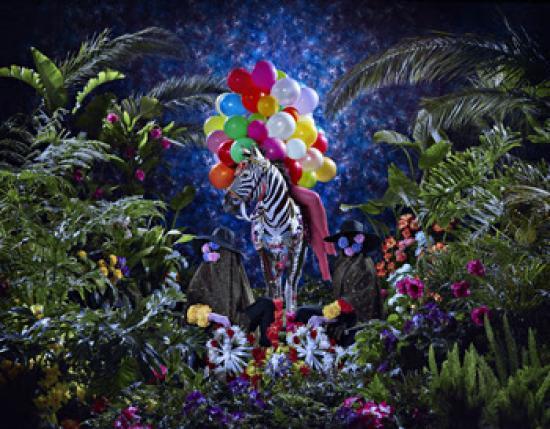Artists Engaged? Maybe
21st June 2014

Artists Engaged? Maybe
We who wished
To lay the foundation of
kindness
Could not ourselves be kind.
Bertold Brecht
"To Those Born After"
21 June-7 September 2014.
Opening: 20 June, 10pm
Calouste Gulbenkian.
Foundation
Av. de Berna, 45
Lisbon
Portugal
Hours: Tuesday-Sunday
10am-6pm
www.gulbenkian.pt
Artists Engaged? Maybe brings together artists from Europe, Africa and South Africa whose work is somehow engaged: an engagement that might be political—but never activist—an engagement with beauty, with art; it might be also an engagement with language(s), or with the communities these artists live in, or for whom they work. This exhibition features more than 20 works in diverse formats: photography, sculpture, painting, drawings, film and video, installations. These are all recent works interrelated with the contemporary world with all of its discontinuities and diverse configurations attributed by these artists.
Works by Athi-Patra Ruga (South Africa), Berna Reale (Brazil), Bouchra Khalili (France/Morocco), Bruno Boudjelal (France/Algeria), Celestino Mudaulane (Mozambique), Conrad Botes (South Africa), Demián Flores (Mexico), Eduardo Basualdo (Argentina), Eva Grubinger (Austria) [with Werner Feiersinger (Austria)], Fredy Alzate (Colombia), João Ferro Martins (Portugal), Johanna Calle (Colombia), Luiz Zerbini (Brazil), Miguel Jara (Colombia), Paul Edmunds (South Africa), Pedro Barateiro (Portugal), Raul Mourão (Brazil), Sandra Monterroso (Guatemala), Simon Gush (South Africa), Solon Ribeiro (Brazil), and Wim Botha (South Africa)
Artists Engaged? Maybe is part of the Next Future/Próximo Futuro summer programming.
See - http://www.proximofuturo.gulbenkian.pt/en
Curator: António Pinto Ribeiro
We who wished
To lay the foundation of kindness
Could not ourselves be kind.
Bertold Brecht, "To Those Born After"
In this exhibition we have sought to avoid the idea of a hegemonic theme justifying the impositions of a curator. There is excessive curatorship in the current system of visual arts, which has given exaggerated authority to mediators—the curators—subjecting works not only to the curatorial criteria but also subjecting curators themselves to specific agendas, where the market and/or academia are crucial, as well as creating a void in polysemy, strangeness, mystery and the unsaid that each piece is supposed to bring with it when presented to its public.
As there was no way to get rid of curatorship, we brought together a group of artists sophisticatedly "engaged" in the present and offered them freedom in the languages they inhabited and the objects they mobilized.
We also resisted the temptation to impose a narrative subjugating all the artists' plasticity, memories or icons. It is an exhibition of fragments, doubts and images in transition or mutation.
And as we are in a world of diverse fragments—that is the power of the arts—we have presented them with works by other artists who could be their comrades, as if they were quotations or footnotes: Die gescheiterte Hoffnung (The Sea of Ice aka The Wreck of Hope) by Caspar David Friedrich; Goya's Saturno devorando a un hijo (Saturn devouring his son); Faces by John Cassavetes; The Grapes of Wrath by John Steinbeck; Chinua Achebe's Things Fall Apart and the lines by Bertolt Brecht quoted above.
The first and fundamental criterion established in bringing the works by participating artists together was a positive answer to the question of whether they recognized themselves in the exhibition's premises and whether they wanted to be a part of it by suggesting works or creating new ones expressly for the event.
-António Pinto Ribeiro
Calouste Gulbenkian Foundation
Created in 1956, the Foundation works in the fields of arts, charity, education and science. Its headquarters are in Lisbon, with delegations running in Paris and in London.
Próximo Futuro/Next Future is a Gulbenkian programme created in 2009 and dedicated in particular, but not exclusively, to contemporary culture in Europe, Africa, Latin America and the Caribbean.
Image
Athi-Patra Ruga, "The Night of the Long Knives III," 2013. Archival inkjet print on Photograph Baryta, edition of 5, 157 x 202 cm. Courtesy of the artist and Whatiftheworld Gallery.



